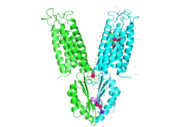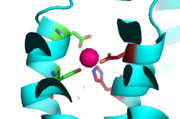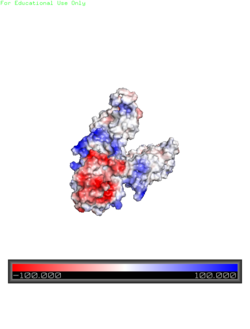Sandbox Reserved 1069
From Proteopedia
| Line 12: | Line 12: | ||
YiiP is a homodimer with each protomer consisting of 238 residues. YiiP has a "Y" shape <scene name='75/756372/Newmainpic/1'> conformation</scene> with two different functional conformations. A total of six helices comprise the transmembrane portion of each <scene name='75/756372/Sixhelices/1'>protomer</scene>. Four of these helices are bundled together while the remaining two are oriented antiparallel to the <scene name='75/756372/2antiparallel/1'>bundle</scene>. Movement of these helices play a role in the function of YiiP. An interlocked salt bridge connects the two domains with the Lys77 and the Asp207 from each protomer - visualized <scene name='75/756372/Saltbridgeclose/1'>here</scene>.This [https://en.wikipedia.org/wiki/Salt_bridge_(protein_and_supramolecular) salt bridge] acts as the hinge for the conformational changes that YiiP undergoes. YiiP has three zinc binding sites, two of which are known to play an active role in the function of YiiP. Site A (link) sits in extracellular space outside of the cell, while site C is situated inside of the cell to act as a sensor of intracellular zinc concentrations. | YiiP is a homodimer with each protomer consisting of 238 residues. YiiP has a "Y" shape <scene name='75/756372/Newmainpic/1'> conformation</scene> with two different functional conformations. A total of six helices comprise the transmembrane portion of each <scene name='75/756372/Sixhelices/1'>protomer</scene>. Four of these helices are bundled together while the remaining two are oriented antiparallel to the <scene name='75/756372/2antiparallel/1'>bundle</scene>. Movement of these helices play a role in the function of YiiP. An interlocked salt bridge connects the two domains with the Lys77 and the Asp207 from each protomer - visualized <scene name='75/756372/Saltbridgeclose/1'>here</scene>.This [https://en.wikipedia.org/wiki/Salt_bridge_(protein_and_supramolecular) salt bridge] acts as the hinge for the conformational changes that YiiP undergoes. YiiP has three zinc binding sites, two of which are known to play an active role in the function of YiiP. Site A (link) sits in extracellular space outside of the cell, while site C is situated inside of the cell to act as a sensor of intracellular zinc concentrations. | ||
| - | === Structural highlights === | ||
| - | + | ||
| + | ===Interlocking Salt Bridge=== | ||
The salt bridge formation between Lys77 and Asp207 of each domain of YiiP form an interlocking salt bridge that acts as the pivot point of the conformational change that drives the function of YiiP. The salt bridge is disrupted when Zinc is bound, due to movement of the antiparallel helices. This disrupts the ion-ion attractions that established the salt bridge- causing a conformational shift in YiiP. This salt bridge also aids in holding the two protomers together. [[Image:Saltbridge.png|200px|left|thumb|Lys77 and Asp207 Salt Bridges]] | The salt bridge formation between Lys77 and Asp207 of each domain of YiiP form an interlocking salt bridge that acts as the pivot point of the conformational change that drives the function of YiiP. The salt bridge is disrupted when Zinc is bound, due to movement of the antiparallel helices. This disrupts the ion-ion attractions that established the salt bridge- causing a conformational shift in YiiP. This salt bridge also aids in holding the two protomers together. [[Image:Saltbridge.png|200px|left|thumb|Lys77 and Asp207 Salt Bridges]] | ||
| - | + | ===Hydrophobic Residues=== | |
<scene name='75/756372/Hydrophobic1/1'>Hydrophobic</scene> residues beneath the salt bridge further stabilize the two domains in the v-shaped void where the domains connect. | <scene name='75/756372/Hydrophobic1/1'>Hydrophobic</scene> residues beneath the salt bridge further stabilize the two domains in the v-shaped void where the domains connect. | ||
| - | + | === Zinc Binding Sites === | |
[[Image:full_view.png|thumb|left|]] | [[Image:full_view.png|thumb|left|]] | ||
Each zinc promoter contains three zinc binding sites. There is an active site (Site A), and two cytoplasmic binding sites (Site B and C). It was found that only site A and C are conserved, while the function of Site B is still unknown, though it seems to play a role in subunit dimerization. | Each zinc promoter contains three zinc binding sites. There is an active site (Site A), and two cytoplasmic binding sites (Site B and C). It was found that only site A and C are conserved, while the function of Site B is still unknown, though it seems to play a role in subunit dimerization. | ||
Revision as of 21:16, 29 March 2017
Introduction
Zinc transporter is an integral membrane protein found in the membrane of Esherichia coli. YiiP is a member of the cation diffusion facilitator family. Members of this family occur all throughout the biological realm. These diffusion facilitators export divalent transition metal ions from the cytoplasm to the extracellular space [1]. They work to regulate the amount of divalent metals inside of the cell, which is biologically relevant because while these metals are necessary for different biological functions, they can prove fatal to the cell in excess amounts. Zinc is essential for the growth and development of cells and zinc levels can affect everything from gene expression to immune response. While YiiP is an integral membrane protein in the cells of Escherichia coli, understanding the mechanism of regulation behind it can help researcher's better understand the cation diffusion facilitator equivalents in eukaryotic cells.
| |||||||||||




